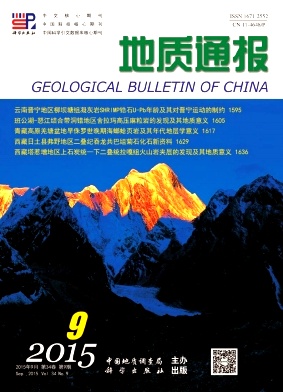NIMA Ciren1,2, WANG Guocan2, DUN Du1,2, CIREN Yangzong1, JIAO Wenlong1, PU Chi1, YE Qiang1, DA Wa1. Petrology, geochemistry and zircon U-Pb age of high potassic shoshonitic volcanic rocks in Shiquanhe area, Tibet[J]. Geological Bulletin of China, 2015, 34(09): 1656-1667.
| Citation: |
NIMA Ciren1,2, WANG Guocan2, DUN Du1,2, CIREN Yangzong1, JIAO Wenlong1, PU Chi1, YE Qiang1, DA Wa1. Petrology, geochemistry and zircon U-Pb age of high potassic shoshonitic volcanic rocks in Shiquanhe area, Tibet[J]. Geological Bulletin of China, 2015, 34(09): 1656-1667.
|
Petrology, geochemistry and zircon U-Pb age of high potassic shoshonitic volcanic rocks in Shiquanhe area, Tibet
-
1. Regional Geological Survey Party, Tibet Bureau of Geology and Mineral Exploration and Development, Doilungdeqen 851400, Tibet, China;2. School of Earth Sciences, China University of Geosciences, Wuhan 430074, Hubei, China
-
Abstract
In this paper, a series of high potassic shoshonitic volcanic rocks are identified for the first time from Late Oligocene Rigongla Formation in southwest Shiquanhe Town, Tibet. The volcanic rocks are composed of quartz-trachyte and biotite trachyte. The zircon U-Pb ages of two samples from different locations are respectively 22.04±0.42Ma and 22.09±0.13Ma. These rocks have SiO2 values from 60.35% to 68.68%, suggesting intermediate-acid rocks. They have high K2O+Na2O values from 8.8% to 10.66%, and K2O/Na2O values from 1.92 to 2.49; the MgO values are comparably low, ranging from 0.88% to 3.47%, and Al2O3 values vary from 14.02% to 14.91%. The major element data show that these rocks belong to high potassic shoshonitic series. The trace element data suggest that magma source might have been derived from the lower crust. The newly-found high potassic shoshonitic volcanic rocks in Shiquanhe area may be considered as the consequence of magma partial melting caused by breakup of the subducted slab when the Indian plate subducted northward in Aquitanian period of Miocene.
-

-
-
Access History







 DownLoad:
DownLoad: